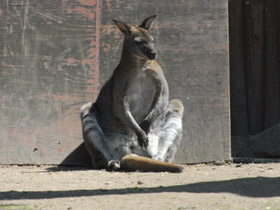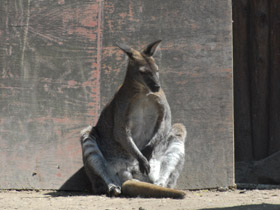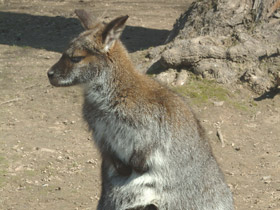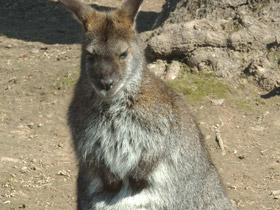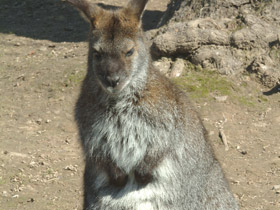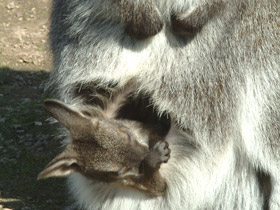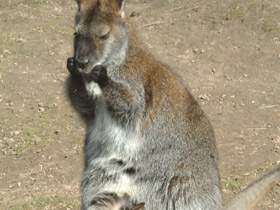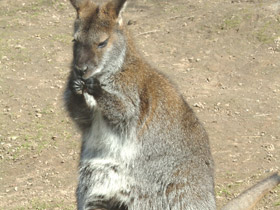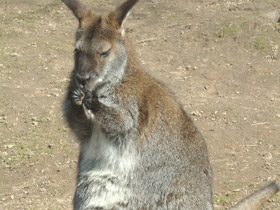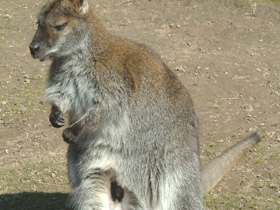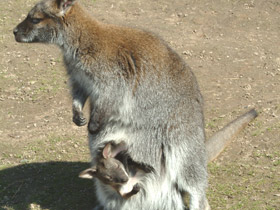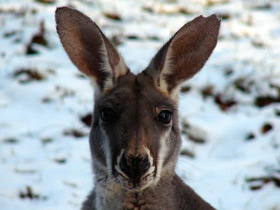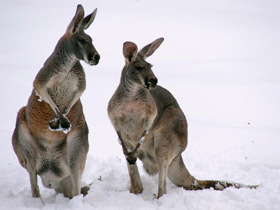The red kangaroo (Osphranter rufus)
Red kangaroo видео
The red kangaroo (Osphranter rufus) is the largest of all kangaroos, the largest terrestrial mammal native to Australia, and the largest extant marsupial. It is found across mainland Australia, except for the more fertile areas, such as southern Western Australia, the eastern and southeastern coasts, and the rainforests along the northern coast.
Taxonomy
The initial description of the species by A.G. Desmarest was published in 1822. The type location was given as an unknown location west of the Blue Mountains. The author assigned the new species to the genus Kangurus. In 1842, Gould reassigned the species to the genus Osphranter, a taxon later submerged as a subgenus of Macropus. A taxonomic restructure in 2015 in Taxonomy of Australian Mammals by Jackson and Groves promoted Osphranter back to the genus level, redefining the red kangaroo, among others, as a species within the genus Osphranter. This was further supported by genetic analysis in 2019.
Appearance
Macropus rufus is the largest kangaroo. It is the largest terrestrial mammal native to Australia, and the largest marsupial in the world. It is found throughout Australia except for the most fertile areas, such as southern Western Australia, the east and southeast coasts, and the rainforests along the north coast. Adult male Macropus rufus reach a body length of 1.5 m (sometimes up to 2 m) and weigh 85 kg (females are much smaller: their body length is 1.1 m and they weigh about 35 kg). The tail of Macropus rufus can be 90-100 cm long. They have long, pointed ears, a broad snout and extremely strong, muscular hind legs and tail. These animals use their hind legs to jump at speeds of up to 60 km/h and can climb more than nine metres in a single leap.
Habitat and nutrition
The kangaroo is found throughout most of Australia, except in the fertile areas of the south and on the east coast and in the rainforests of the north. Macropus rufus inhabits arid savannah habitats and can live without water for long periods of time.
They feed mainly on grasses and flowering plants.
Locomotion
The red kangaroo's legs work much like a rubber band, with the Achilles tendon stretching as the animal comes down, then releasing its energy to propel the animal up and forward, enabling the characteristic bouncing locomotion. They can reach speeds of around 60 km/h (37 mph). The males can cover 8-9 m (26-30 ft) in one leap while reaching heights of 1.8-3 m (5 ft 11 in - 9 ft 10 in), though the average is 1.2-1.9 m (3 ft 11 in - 6 ft 3 in).
Reproduction
Like other marsupials, the female Macropus rufus gives birth to a small calf weighing no more than 1 g and measuring about 2 cm. Immediately after birth, it clings to the skin of its mother's belly and manages to crawl across her belly and into the pouch. Here it grabs one of the four teats with its mouth and sucks on it for the next 2.5 months. Gradually, the calf grows, develops, opens its eyes and coats itself. It then starts to make short trips out of the pouch, immediately jumping back in at the slightest rustle. The calf leaves its mother's marsupium only at eight months of age, and she immediately gives birth to another calf, which makes its way into the marsupium, to another teat. What is most striking is that, from this point on, the female produces two types of milk: more fat to feed the older calf and less fat for the newborn.
Relationship with humans
The red kangaroo is an abundant species and has even benefited from the spread of agriculture and creation of man-made waterholes. However, competition with livestock and rabbits poses a threat. It is also sometimes shot by farmers as a pest, although in Queensland and New South Wales a permit is required.
Kangaroos dazzled by headlights or startled by engine noise often leap in front of vehicles, severely damaging or destroying smaller or unprotected vehicles. The risk of harm to vehicle occupants is greatly increased if the windscreen is the point of impact. As a result, "kangaroo crossing" signs are commonplace in Australia.
Peak times for kangaroo/vehicle crashes are between 5:00 PM and 10:00 PM, in winter, and after extended dry-weather spells.
Commercial use
Like all Australian wildlife, the red kangaroo is protected by legislation, but it is so numerous that there is regulated harvest of its hide and meat. Hunting permits and commercial harvesting are controlled under nationally approved management plans, which aim to maintain red kangaroo populations and manage them as a renewable resource. Harvesting of kangaroos is controversial, particularly due to the animal's popularity.
In the year 2000, 1,173,242 animals were killed. In 2009 the government put a limit of 1,611,216 for the number of red kangaroos available for commercial use. The kangaroo industry is worth about A$270 million each year, and employs over 4000 people. The kangaroos provide meat for both humans and pet food. Kangaroo meat is very lean with only about 2% fat. Their skins are used for leather.

















